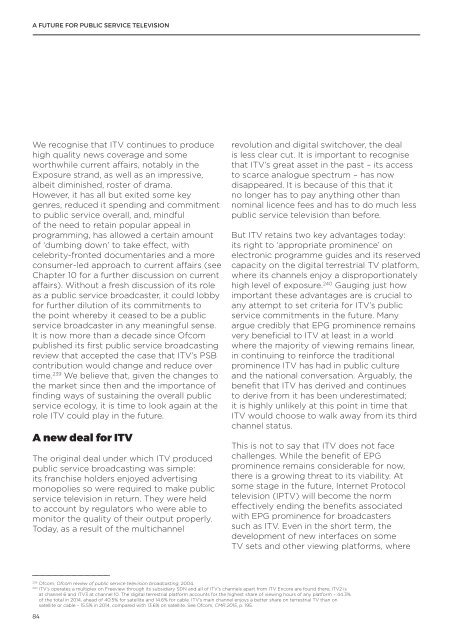A FUTURE FOR PUBLIC SERVICE TELEVISION CONTENT AND PLATFORMS IN A DIGITAL WORLD
FOTV-Report-Online-SP
FOTV-Report-Online-SP
Create successful ePaper yourself
Turn your PDF publications into a flip-book with our unique Google optimized e-Paper software.
A <strong>FUTURE</strong> <strong>FOR</strong> <strong>PUBLIC</strong> <strong>SERVICE</strong> <strong>TELEVISION</strong><br />
We recognise that ITV continues to produce<br />
high quality news coverage and some<br />
worthwhile current affairs, notably in the<br />
Exposure strand, as well as an impressive,<br />
albeit diminished, roster of drama.<br />
However, it has all but exited some key<br />
genres, reduced it spending and commitment<br />
to public service overall, and, mindful<br />
of the need to retain popular appeal in<br />
programming, has allowed a certain amount<br />
of ‘dumbing down’ to take effect, with<br />
celebrity-fronted documentaries and a more<br />
consumer-led approach to current affairs (see<br />
Chapter 10 for a further discussion on current<br />
affairs). Without a fresh discussion of its role<br />
as a public service broadcaster, it could lobby<br />
for further dilution of its commitments to<br />
the point whereby it ceased to be a public<br />
service broadcaster in any meaningful sense.<br />
It is now more than a decade since Ofcom<br />
published its first public service broadcasting<br />
review that accepted the case that ITV’s PSB<br />
contribution would change and reduce over<br />
time. 239 We believe that, given the changes to<br />
the market since then and the importance of<br />
finding ways of sustaining the overall public<br />
service ecology, it is time to look again at the<br />
role ITV could play in the future.<br />
A new deal for ITV<br />
The original deal under which ITV produced<br />
public service broadcasting was simple:<br />
its franchise holders enjoyed advertising<br />
monopolies so were required to make public<br />
service television in return. They were held<br />
to account by regulators who were able to<br />
monitor the quality of their output properly.<br />
Today, as a result of the multichannel<br />
revolution and digital switchover, the deal<br />
is less clear cut. It is important to recognise<br />
that ITV’s great asset in the past – its access<br />
to scarce analogue spectrum – has now<br />
disappeared. It is because of this that it<br />
no longer has to pay anything other than<br />
nominal licence fees and has to do much less<br />
public service television than before.<br />
But ITV retains two key advantages today:<br />
its right to ‘appropriate prominence’ on<br />
electronic programme guides and its reserved<br />
capacity on the digital terrestrial TV platform,<br />
where its channels enjoy a disproportionately<br />
high level of exposure. 240 Gauging just how<br />
important these advantages are is crucial to<br />
any attempt to set criteria for ITV’s public<br />
service commitments in the future. Many<br />
argue credibly that EPG prominence remains<br />
very beneficial to ITV at least in a world<br />
where the majority of viewing remains linear,<br />
in continuing to reinforce the traditional<br />
prominence ITV has had in public culture<br />
and the national conversation. Arguably, the<br />
benefit that ITV has derived and continues<br />
to derive from it has been underestimated;<br />
it is highly unlikely at this point in time that<br />
ITV would choose to walk away from its third<br />
channel status.<br />
This is not to say that ITV does not face<br />
challenges. While the benefit of EPG<br />
prominence remains considerable for now,<br />
there is a growing threat to its viability. At<br />
some stage in the future, Internet Protocol<br />
television (IPTV) will become the norm<br />
effectively ending the benefits associated<br />
with EPG prominence for broadcasters<br />
such as ITV. Even in the short term, the<br />
development of new interfaces on some<br />
TV sets and other viewing platforms, where<br />
239<br />
Ofcom, Ofcom review of public service television broadcasting, 2004.<br />
240<br />
ITV’s operates a multiplex on Freeview through its subsidiary SDN and all of ITV’s channels apart from ITV Encore are found there; ITV2 is<br />
at channel 6 and ITV3 at channel 10. The digital terrestrial platform accounts for the highest share of viewing hours of any platform – 44.3%<br />
of the total in 2014, ahead of 40.5% for satellite and 14.6% for cable. ITV’s main channel enjoys a better share on terrestrial TV than on<br />
satellite or cable – 15.5% in 2014, compared with 13.6% on satellite. See Ofcom, CMR 2015, p. 195.<br />
84


